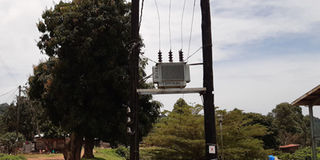Joy as Kalangala’s Buggala Island is connected to power

One of the new transformers erected in Kalangala Town Council in Kalangala District. Government is improving power supply in the area. PHOTO | SYLVESTER SSEMUGENYI
What you need to know:
- Power lines in Buggala Island have been added to the national radar system to ensure a quick response to emergencies
Buggala Island in Kalangala District, which had for a long period faced a shortage of electricity, has been connected to the national grid.
This milestone follows the completion of laying a 6km submarine power cable on the bed of Lake Victoria, which now transports electricity from Bukakkata on the mainland to Bugoma in Kalangala District.
Mr Julius Wandera, the director of corporate and consumer affairs at the Electricity Regulatory Authority (ERA), said: “We are currently doing reviewing of the tariffs to see that they are at par with those levied in Masaka. We are optimistic that this will automatically lead to reduced power tariffs for both domestic and commercial users.’’
Mr Wandera added that power lines in Buggala Island have also been added to the national radar system to monitor the flow of power and ensure a quick response in case of emergencies.
According to Kalangala District leaders and locals, electricity from the national grid brings hope for reduced production costs.
“Over five investors closed businesses because of the high power tariffs that increased the cost of doing business. However, we are now full of hope that we shall finally have reliable and affordable electricity for both commercial and domestic customers,’’ said Mr Rajab Semakula, the Kalangala District chairperson.
Currently, domestic customers in Kalangala are charged Shs1,213.2 per kWh, while commercial customers are charged Shs1,608.6 per kWh, which residents say are exorbitantly high compared to what power consumers on the mainland pay. The cost of electricity per kWh in Kalangala has always been determined by production costs, coupled with commercial losses arising from power theft and destruction of machines at the generation plant in Bukuzindu Village.
“In the past year, we have been suffering regular load-shedding between 12am and 5am, but this is no more,’’ Mr Robert Sebalamu, a resident of Buggala Village, said.
However, some islanders complain of occasional power outages in certain villages but are hopeful that this will soon become a thing of the past.
“Power outages are frequent during the day, and sometimes it is not enough to run the machines, so we switch off the radio. But we think this is short-lived since they are still testing the new system,’’ said Mr Hussein Ddungu, a news editor at Radio Ssese in Kalangala Town Council.
Connecting Kalangala to the national power grid is expected to further stimulate development in the area.
Previously, residents and businesses relied on the thermal solar hybrid power plant at Bukuzindu Village run by Kalangala Infrastructure Services (KIS), which generates only 1.6 megawatts.
Background
Kalangala first received electricity in 2005, with a geothermal power station operating six hours a day, covering only Kalangala Town Council. But two years later, residents’ complaints prompted the government, through Electricity Regulatory Authority (ERA), to provide power for 10 hours – six hours during the day and four at night. In 2013, the government brought on board Kalangala Infrastructure Services (KIS) through a public-private partnership to provide full-time power supply on Buggala Main Island.




